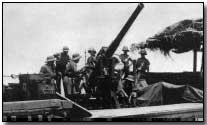Battles - The Capture of Amara, 1915
 The Capture of the important Turkish administrative base of Amara in late May 1915 was a
remarkable triumph for both the British and its commander of the Amara
expedition,
Sir
Charles Townshend.
The Capture of the important Turkish administrative base of Amara in late May 1915 was a
remarkable triumph for both the British and its commander of the Amara
expedition,
Sir
Charles Townshend.
Also an important commercial centre Amara was sited on the Tigris river, and some 160km north of Qurna which British forces had captured in December 1914. Travel between Qurna and Amara was made difficult by land flooding - to a depth of three feet - and thus was only feasible by shallow draught boat.
Nevertheless the freshly-arrived regional British Commander-in-Chief, Sir John Nixon, was determined to continue the Indian administration's policy of 'forward defence'.
In this Nixon and the Indian government were in conflict with the wishes of the London War Office; the former intended to pursue an aggressive strategy, while the latter favoured a more cautious approach designed simply to protect critical British oil interests in the region.
However Nixon, buoyed by success in repulsing a Turkish offensive at Shaiba in April 1915, argued persuasively that unless Amara itself was seized the British HQ at Basra lay under potential threat. The Indian administration was quick to agree; the government in London more reluctantly so.
 Thus,
in spite of a definite shortage of equipment and supplies - notably medical
supplies - Nixon, who remained at Basra, authorised newly-arrived Sir
Charles Townshend (in charge of the 6th (Poona) Division) to begin
operations.
Thus,
in spite of a definite shortage of equipment and supplies - notably medical
supplies - Nixon, who remained at Basra, authorised newly-arrived Sir
Charles Townshend (in charge of the 6th (Poona) Division) to begin
operations.
Consequently a haphazard fleet of some 500 flat-bottomed boats was assembled in readiness for an expedition to Amara. Each craft bore as much artillery as it could safely bear, machine guns and mountain guns among them.
Commencing on 31 May 1915 Townshend's operation quickly secured Turkish outposts. News from reconnaissance aircraft reached Townshend the following day indicating that the main Turkish force at Ruta had opted to move north towards Amara.
Townshend promptly decided to pursue them, boarding the Espeigle and designating it his HQ. With Royal Navy support Townshend's 'regatta' (as it subsequently became known) set off quickly in pursuit.
Remarkably leaving his supporting infantry far behind - some 80km in his wake - Townshend paused on the evening of 1 June when his force sighted the rear of the Turkish force. Continuing the next day with Amara still some 80km ahead Townshend passed abandoned Turkish shipping. This augured well and he took the decision to proceed.
Arriving in Amara on the afternoon of 3 June, Townshend's tiny advance force of 100 British sailors and soldiers nevertheless persuaded the garrison of 2,000 there to surrender, the latter convinced that a hefty British army was shortly to arrive. Maintaining the bluff throughout the day Townshend was joined by the arrival of his main force the following day.
Townshend's reputation soared as news of the spectacular capture of Amara spread. More ominously it encouraged Nixon to aggressively push further up the Tigris, in spite of tightly stretched supply lines and extreme shortages of equipment.
Such a policy suggested imminent disaster; it duly arrived at Ctesiphon in late November 1915.
Click here to view a map charting operations in Mesopotamia through to 1917.
Photographs courtesy of Photos of the Great War website
Russia mobilised 12 million men during the war; France 8.4 million; Britain 8.9 million; Germany 11 million; Austria-Hungary 7.8 million; Italy 5.6 million; and the USA 4.3 million.
- Did you know?
